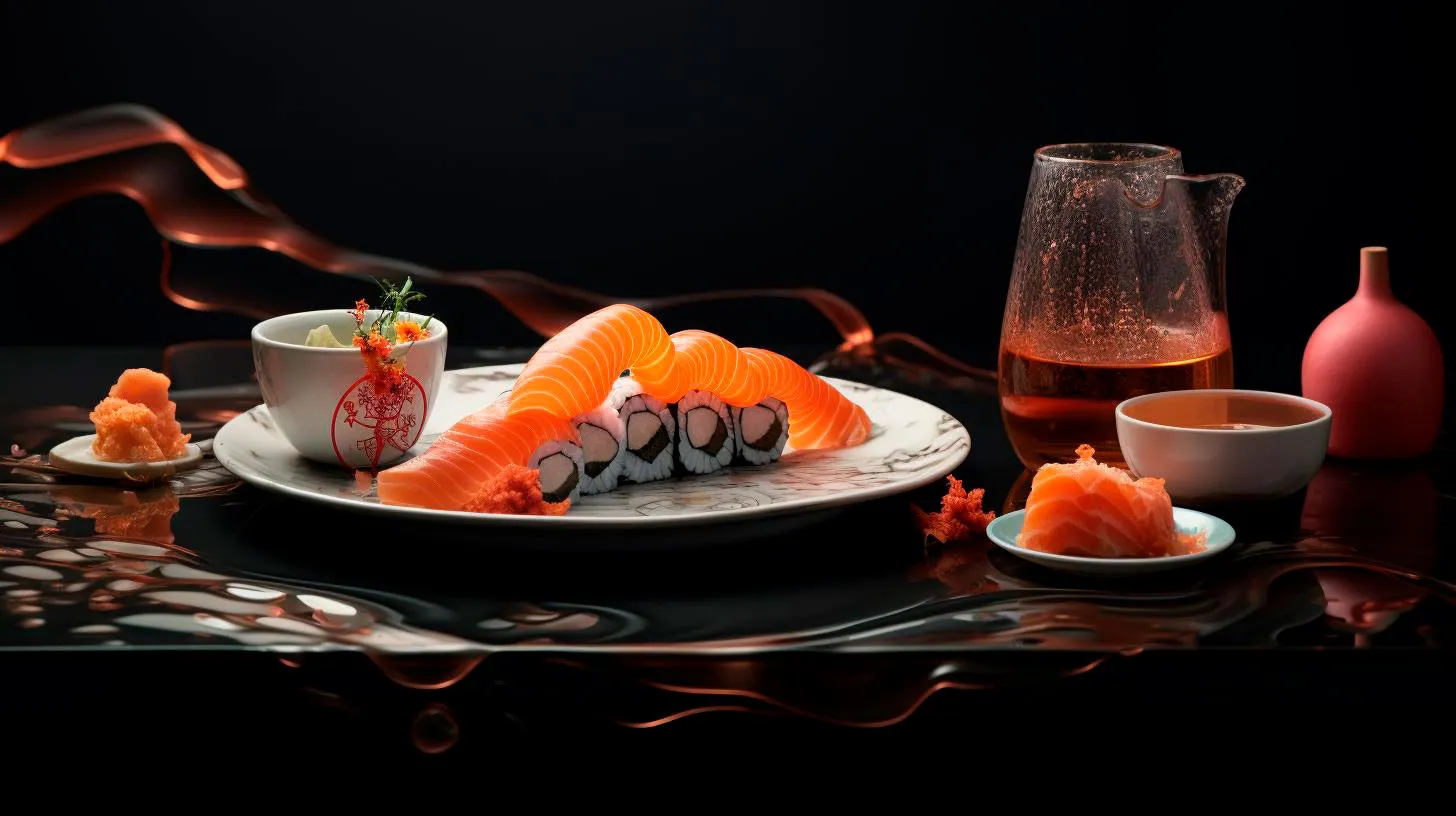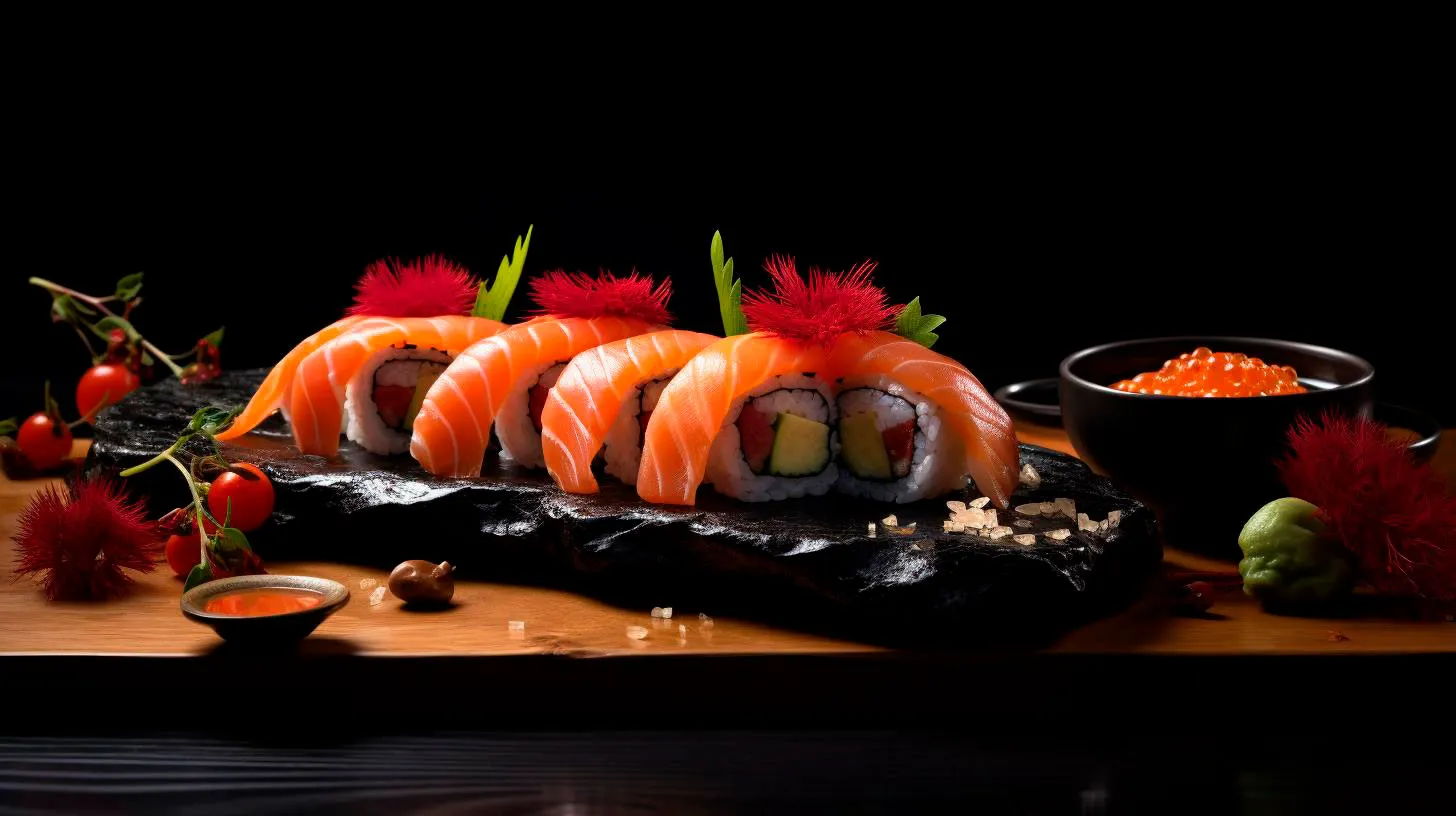Rice Science: Decoding the Role of Sushi Staple Ingredient
The Science of Sushi Rice
It’s no secret that sushi rice is different from your regular steamed rice. Specially prepared sushi rice, also known as shari, is a product of meticulous cooking, seasoning, and cooling techniques. Understanding the science behind sushi rice is essential to mastering the art of sushi making. Let’s take a closer look at some key points:
The Perfect Rice Grain
Rice grains used in sushi must possess specific qualities to achieve the desired texture. Short-grain varieties like japonica rice are most commonly used due to their high starch content. This helps the rice grains stick together, allowing them to be easily shaped into sushi rolls or nigiri.
- Key Takeaway: The ideal rice grain for sushi has a high starch content, making it stick together when shaped.
Cooking and Seasoning
Cooking sushi rice involves precision and attention to detail. The grains must be cooked to perfection – tender and slightly sticky, yet still firm enough to hold their shape. Seasoning the rice with a mixture of rice vinegar, sugar, and salt is crucial to achieve that delicate balance of flavors.
- Key Takeaway: Proper cooking and seasoning techniques are crucial to create the perfect sushi rice texture and taste.
The Role of Rice Vinegar
Rice vinegar not only adds a tangy flavor but also plays a vital role in inhibiting the growth of bacteria that could spoil the sushi. It helps preserve the rice while enhancing its texture and taste. The acidity of rice vinegar also makes sushi rice more digestible.
- Key Takeaway: Rice vinegar not only adds flavor but also acts as a preservative and improves the digestion of sushi rice.
Rice-Related Innovation
Rice science and innovation continue to evolve, consistently improving the sushi experience. Here are a few noteworthy developments:
Nutritionally Enriched Rice
Researchers and scientists are exploring ways to enhance the nutritional value of rice. Through biofortification techniques, they have successfully increased essential nutrients like iron, zinc, and vitamins in rice varieties. This ensures that sushi lovers can enjoy a healthier meal without compromising on taste.
- Key Takeaway: Biofortification techniques have led to the development of rice varieties with enhanced nutritional value for a healthier sushi experience.
Alternative Rice Options
Traditionally, sushi is made using white rice. However, sushi lovers can now explore alternative rice options to suit their dietary preferences. Brown rice and black rice are gaining popularity due to their higher fiber content and potential health benefits. These alternatives offer a unique twist to sushi and cater to a wider range of consumer needs.
- Key Takeaway: Brown rice and black rice provide healthier alternatives to traditional white rice in sushi, offering added dietary benefits.
The Importance of Proper Rice Handling
Proper rice handling is crucial to ensure food safety and maintain the quality of sushi. Here are a few essential practices:
Temperature Control
Rice should be cooled down quickly after cooking to prevent bacterial growth. Storing and handling rice at the appropriate temperature ensures the sushi remains safe to consume.
- Key Takeaway: Rapid cooling of cooked rice is vital to prevent the growth of harmful bacteria and maintain sushi quality.
Hygiene and Freshness
Good hygiene practices are essential when handling sushi rice. Hands, utensils, and preparation surfaces must be clean to prevent contamination. Additionally, using fresh ingredients and incorporating proper storage techniques are necessary to maintain sushi quality.
- Key Takeaway: Maintaining high hygiene standards and using fresh ingredients are essential in sushi preparation to avoid any foodborne illnesses.
The Future of Rice in Sushi
As scientific advancements continue and consumer preferences evolve, the role of rice in sushi is set to see further transformation. Innovative techniques might emerge to create alternative sushi rice options that cater to various dietary needs without compromising authenticity. The sustainable cultivation of rice and its impact on the environment is also a focus area for future development.
In conclusion, sushi rice is not just a mere accompaniment to seafood, but a pivotal element responsible for the unique taste and texture of sushi. Understanding the science behind rice and keeping up with rice-related innovation allows sushi enthusiasts to appreciate the art of sushi-making while enjoying a safe and delicious dining experience.
From Ocean to Plate: Unraveling the Journey of Sushi Ingredients
Join us as we embark on a gastronomic adventure and explore the intricate journey of sushi ingredients, from the depths of the ocean to your dining table.
The Ocean’s Bounty: Sourcing the Finest Seafood
At the heart of any good sushi lies the freshest and highest quality seafood. Sourcing these ingredients begins with a carefully orchestrated dance between skilled fishermen and the vast ocean itself. As they set sail in their vessels, equipped with state-of-the-art fishing gear, their goal is to capture prized fish like tuna, salmon, and yellowtail.
- Key Takeaway: Only the finest seafood makes its way into sushi, ensuring a delectable culinary experience for sushi enthusiasts.
- Advantage: By sourcing seafood from the ocean, sushi chefs can offer a diverse range of flavors and textures, providing an unparalleled dining experience.
Farm to Table: Aquaculture’s Role in Sushi Ingredients
While the ocean is the primary source of seafood, the ever-growing demand for sushi has led to the rise of aquaculture. Farms dedicated to cultivating fish play a crucial role in ensuring a steady supply of sushi-grade ingredients. With controlled environments and specialized techniques, these farms can produce exceptional seafood while minimizing the impact on wild populations.
- Advantage: Aquaculture allows for a sustainable supply of sushi ingredients, reducing the strain on wild fish stocks and promoting responsible consumption.
- Feature: Farms use advanced techniques to create an optimal habitat for fish, resulting in flavors that are on par with their ocean-caught counterparts.
From Fields to Garnish: The World of Vegetables
While seafood takes center stage in sushi, the supporting cast of vegetables adds a burst of flavor and a vibrant touch to each bite. The journey of these ingredients begins on the fertile fields and carefully tended gardens where farmers cultivate a variety of vegetables like cucumbers, carrots, and avocados.
- Feature: Farmers employ sustainable agricultural practices, ensuring that the vegetables used in sushi are free from harmful chemicals and full of natural goodness.
- Key Takeaway: The combination of fresh vegetables with succulent seafood creates a harmony of flavors that dance on your palate.
The Craftsmanship: Sourcing the Best Rice
No sushi is complete without perfectly cooked, seasoned rice, which serves as the foundation for each delectable morsel. When it comes to sourcing this essential ingredient, sushi chefs rely on rice fields that have been cultivated with care and precision. Known for their expertise, farmers meticulously grow and harvest the finest grains of rice, ensuring the highest quality product.
- Advantage: Sourcing rice directly from farmers allows sushi chefs to control and maintain the exceptional quality that lies at the heart of every sushi masterpiece.
- Feature: The meticulous selection process ensures that only the best rice varieties, such as short-grain Japonica rice, are used in sushi, providing the perfect texture and flavor.
The Culmination: The Artistry of Sushi
As the carefully sourced ingredients make their way to the sushi bar, it is the skilled hands of the sushi chef that bring them to life. Guided by years of experience and refined techniques, these culinary artists transform the ingredients into exquisite pieces of art that are both visually stunning and delightfully tasty.
- Key Takeaway: Sushi is a testament to the fusion of culinary techniques and artistic expression, elevating it into an experience that tantalizes all your senses.
- Feature: Each piece of sushi is meticulously crafted, showcasing the chef’s attention to detail and dedication to perfection.
From the depths of the ocean to the craftsmanship of the sushi chef, the journey of sushi ingredients is one that demands utmost care and passion. The next time you savor a piece of sushi, take a moment to appreciate the dedication and artistry that went into creating that culinary masterpiece.
Sushi: A Nutritional Powerhouse Packed with Health Benefits
The Nutritional Value of Sushi
Sushi is a well-rounded meal that provides a balanced combination of macronutrients and essential vitamins and minerals. Here’s a breakdown of key nutrients found in sushi:
- Protein: Sushi is an excellent source of lean proteins due to the presence of fish, seafood, and tofu. Proteins are essential for building and repairing tissues, supporting the immune system, and promoting overall well-being.
- Healthy Fats: Fish varieties like salmon, tuna, and mackerel are packed with omega-3 fatty acids, which contribute to heart health, reduce inflammation, and support brain function.
- Carbohydrates: Sushi contains carbohydrates in the form of rice. While some people may worry about the high carbohydrate content, it provides energy for the body and can be balanced by choosing options with more vegetables and less rice.
- Vitamins and Minerals: Sushi often incorporates nutrient-rich ingredients like seaweed, avocado, and vegetables, providing essential vitamins such as vitamin C, vitamin K, and minerals like iodine and magnesium.
Health Benefits of Sushi
Sushi offers various health benefits that can contribute to your overall well-being:
- Heart Health: Omega-3 fatty acids in fish help reduce the risk of heart disease by improving cholesterol levels, lowering blood pressure, and reducing inflammation.
- Weight Management: Sushi can be a great option for those looking to maintain or lose weight. Opting for rolls with more vegetables and lean protein while reducing ones with fried ingredients can help control calorie intake.
- Brain Function: The omega-3 fatty acids found in fish are essential for brain health and development. Regular consumption of sushi can enhance cognitive function and reduce the risk of cognitive decline.
- Antioxidant Boost: Sushi often includes seaweed, which is rich in antioxidants, vitamins, and minerals. These compounds help protect cells from damage caused by harmful free radicals.
- Improved Digestion: The probiotics found in fermented sushi options like traditional Japanese pickled vegetables (tsukemono) and miso soup support a healthy gut, aiding in digestion and enhancing nutrient absorption.
Choosing Sushi Wisely
While sushi offers numerous health benefits, it’s essential to make wise choices to maximize its nutritional value:
- Freshness: Opt for sushi made with fresh, high-quality ingredients to ensure maximum flavor and nutritional value.
- Portion Control: Sushi rolls can vary in size and calorie content. Be mindful of portion sizes and choose rolls with a balance of protein, vegetables, and rice.
- Salt Intake: Be aware of the sodium content in sushi. Some varieties like soy sauce can be high in sodium, so use them sparingly or opt for reduced-sodium alternatives.
- Allergies and Dietary Restrictions: If you have any food allergies or dietary restrictions, communicate them to the sushi chef to ensure your meal is prepared safely.
In conclusion, sushi is not only a delicious culinary experience but also a nutritional powerhouse. Packed with lean proteins, healthy fats, and vital nutrients, sushi offers numerous health benefits, including improved heart health, weight management, and enhanced brain function. When choosing sushi, prioritize freshness, portion control, and consider your dietary needs. So why not indulge in this flavorful and healthy delight?
Key Takeaways:
- Sushi is a well-rounded meal that provides a balanced combination of macronutrients and essential vitamins and minerals.
- Key nutrients found in sushi include proteins, healthy fats, carbohydrates, vitamins, and minerals.
- Sushi offers health benefits such as improved heart health, weight management, brain function, antioxidant support, and enhanced digestion.
- Choose sushi made with fresh ingredients, practice portion control, watch your salt intake, and consider any allergies or dietary restrictions.
The Art of Sushi Crafting: Unlocking Ancient Culinary Techniques
In this article, we will delve into the art of sushi crafting, exploring the ancient techniques that have been passed down through generations.
A Glimpse into History
Sushi, which originated in Southeast Asia over 2,000 years ago, underwent a remarkable evolution to become the globally recognized delicacy it is today. Originally, sushi was a means to preserve fish by fermenting it with rice and salt. Over time, this preservation technique transformed into an exquisite culinary style characterized by fresh ingredients and meticulous preparation.
The Essentials: Quality Ingredients and Knife Skills
At the heart of sushi crafting lies the use of high-quality ingredients. Fresh fish, such as tuna, salmon, and yellowtail, are key components of sushi. Furthermore, the rice used in sushi, known as “shari,” must be perfectly cooked and seasoned with a delicate balance of vinegar, sugar, and salt. Alongside the seafood, sushi can incorporate vegetables, such as cucumber or avocado, and other complementary ingredients like seaweed or roe.
However, it is the knife skills of sushi chefs that truly elevate the art. The precision and expertise required to slice the fish into perfectly sized pieces, such as sashimi or nigiri, is unparalleled. The mastery of knife techniques, such as “hira-zukuri” (flat slice) or “usuzukuri” (thin slice), guarantees uniformity and enhances the taste and presentation of sushi.
The Role of Presentation
Sushi is not just about its taste; its presentation is equally important. The meticulous arrangement of sushi pieces on a plate, along with the garnishes and accompanying sauces, creates a visually stunning experience for diners. The colors, textures, and shapes of the ingredients are carefully considered to provide an aesthetic delight in addition to a gastronomic one.
Advancements in Sushi Presentation
In recent years, sushi presentation has taken on a more creative and artistic approach. Chefs are now incorporating innovative techniques inspired by Japanese culture and other art forms. For example, some sushi creations resemble miniature landscapes or showcase intricate patterns using ingredients like edible flowers or gold leaf. These advancements not only impress diners visually but also demonstrate the timeless adaptability of the sushi craft.
Preserving Tradition: Authentic Sushi Experiences
While sushi has gained international popularity, it is vital to preserve the authenticity and integrity of this ancient culinary art. To truly appreciate the nuances of sushi crafting, it is essential to experience it firsthand at traditional sushi establishments.
Key Takeaways
- Sushi crafting is an ancient culinary art that has been refined over centuries.
- High-quality ingredients, particularly fish and rice, form the foundation of sushi.
- Knife skills are crucial for the precise cutting techniques required in sushi making.
- The presentation of sushi is an art form in itself, with a focus on visual aesthetics.
- Sushi presentation has evolved to incorporate creative and artistic elements.
- Authentic sushi experiences are the best way to fully appreciate this ancient craft.
In conclusion, sushi crafting is a timeless art that showcases the rich culinary heritage of Japan. From the careful selection of fresh ingredients to the precise knife skills and artistic presentation, sushi chefs embrace a tradition that has been perfected over centuries. Whether you are a sushi lover or an aspiring chef, delving into the world of sushi crafting is sure to be a fascinating and rewarding journey.



